JEEP COMPASS 2021 Owner handbook (in English)
Manufacturer: JEEP, Model Year: 2021, Model line: COMPASS, Model: JEEP COMPASS 2021Pages: 328, PDF Size: 8.85 MB
Page 121 of 328
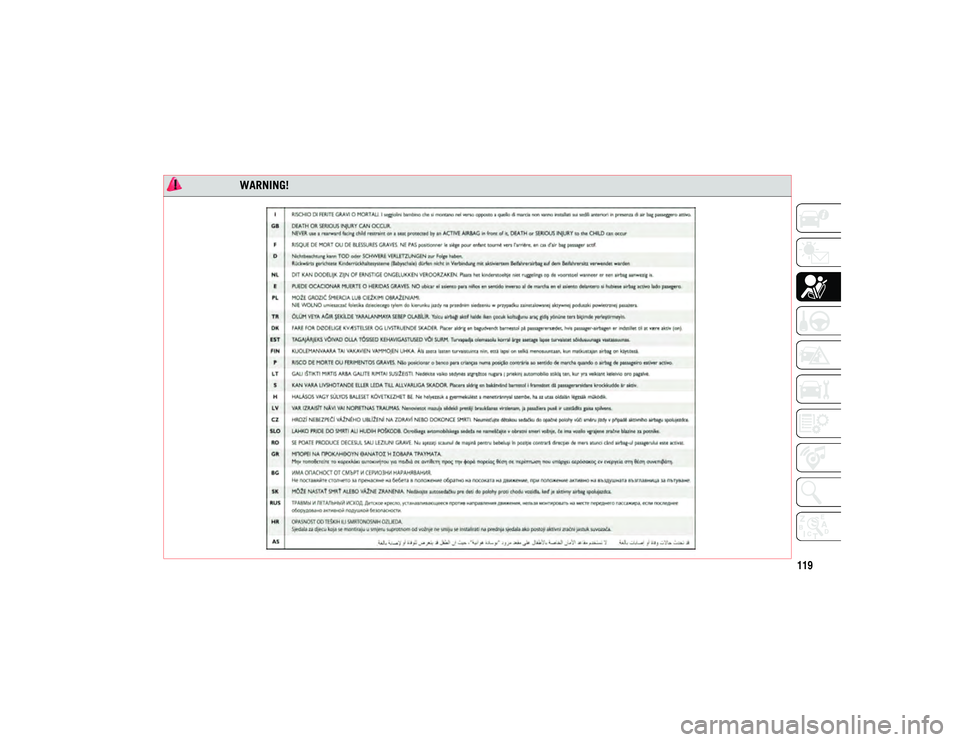
119
WARNING!
2020_JEEP_M6_UG_UK.book Page 119
Page 122 of 328
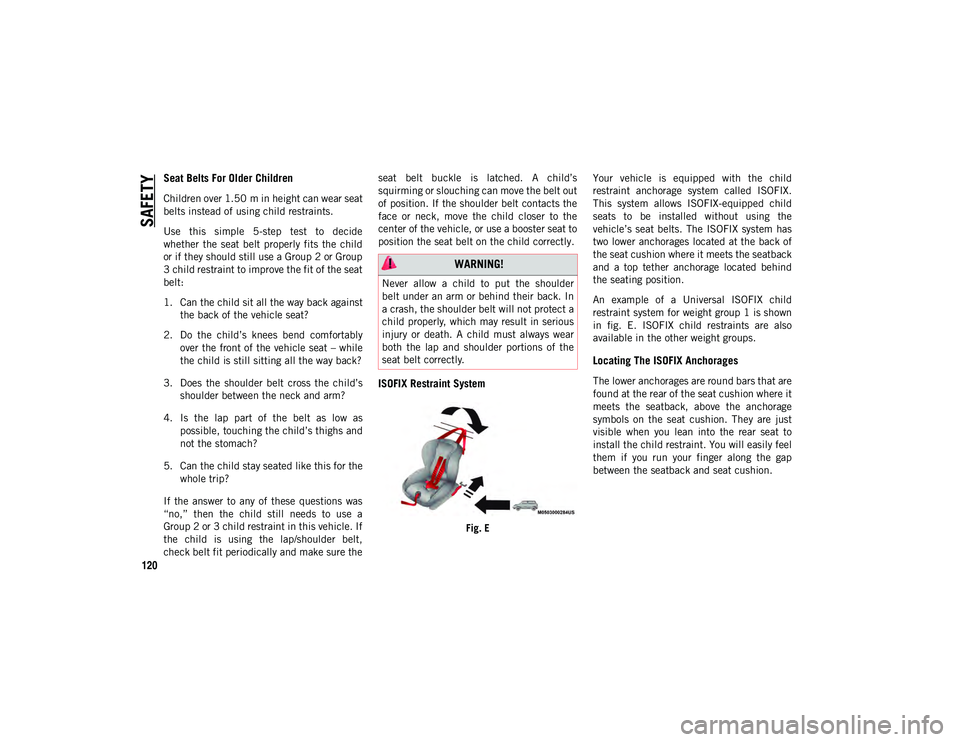
SAFETY
120
Seat Belts For Older Children
Children over 1.50 m in height can wear seat
belts instead of using child restraints.
Use this simple 5-step test to decide
whether the seat belt properly fits the child
or if they should still use a Group 2 or Group
3 child restraint to improve the fit of the seat
belt:
1. Can the child sit all the way back againstthe back of the vehicle seat?
2. Do the child’s knees bend comfortably over the front of the vehicle seat – while
the child is still sitting all the way back?
3. Does the shoulder belt cross the child’s shoulder between the neck and arm?
4. Is the lap part of the belt as low as possible, touching the child’s thighs and
not the stomach?
5. Can the child stay seated like this for the whole trip?
If the answer to any of these questions was
“no,” then the child still needs to use a
Group 2 or 3 child restraint in this vehicle. If
the child is using the lap/shoulder belt,
check belt fit periodically and make sure the seat belt buckle is latched. A child’s
squirming or slouching can move the belt out
of position. If the shoulder belt contacts the
face or neck, move the child closer to the
center of the vehicle, or use a booster seat to
position the seat belt on the child correctly.
ISOFIX Restraint System
Fig. E
Your vehicle is equipped with the child
restraint anchorage system called ISOFIX.
This system allows ISOFIX-equipped child
seats to be installed without using the
vehicle’s seat belts. The ISOFIX system has
two lower anchorages located at the back of
the seat cushion where it meets the seatback
and a top tether anchorage located behind
the seating position.
An example of a Universal ISOFIX child
restraint system for weight group 1 is shown
in fig. E. ISOFIX child restraints are also
available in the other weight groups.
Locating The ISOFIX Anchorages
The lower anchorages are round bars that are
found at the rear of the seat cushion where it
meets the seatback, above the anchorage
symbols on the seat cushion. They are just
visible when you lean into the rear seat to
install the child restraint. You will easily feel
them if you run your finger along the gap
between the seatback and seat cushion.
WARNING!
Never allow a child to put the shoulder
belt under an arm or behind their back. In
a crash, the shoulder belt will not protect a
child properly, which may result in serious
injury or death. A child must always wear
both the lap and shoulder portions of the
seat belt correctly.
2020_JEEP_M6_UG_UK.book Page 120
Page 123 of 328
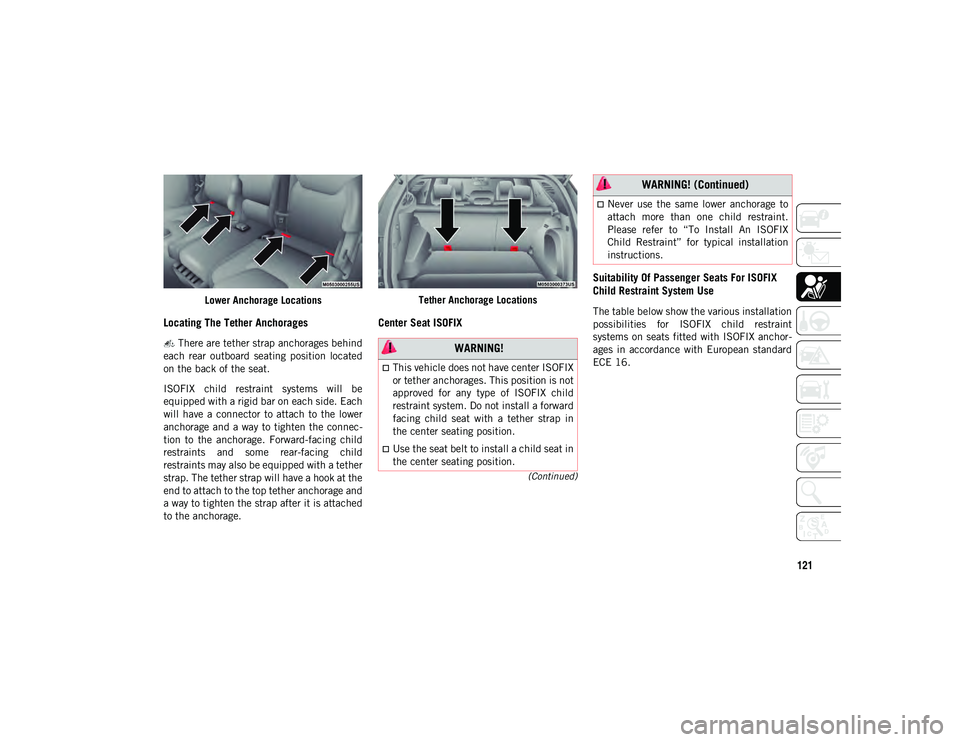
121
(Continued)
Lower Anchorage Locations
Locating The Tether Anchorages
There are tether strap anchorages behind
each rear outboard seating position located
on the back of the seat.
ISOFIX child restraint systems will be
equipped with a rigid bar on each side. Each
will have a connector to attach to the lower
anchorage and a way to tighten the connec -
tion to the anchorage. Forward-facing child
restraints and some rear-facing child
restraints may also be equipped with a tether
strap. The tether strap will have a hook at the
end to attach to the top tether anchorage and
a way to tighten the strap after it is attached
to the anchorage. Tether Anchorage Locations
Center Seat ISOFIX
Suitability Of Passenger Seats For ISOFIX
Child Restraint System UseThe table below show the various installation
possibilities for ISOFIX child restraint
systems on seats fitted with ISOFIX anchor
-
ages in accordance with European standard
ECE 16.
WARNING!
This vehicle does not have center ISOFIX
or tether anchorages. This position is not
approved for any type of ISOFIX child
restraint system. Do not install a forward
facing child seat with a tether strap in
the center seating position.
Use the seat belt to install a child seat in
the center seating position.
Never use the same lower anchorage to
attach more than one child restraint.
Please refer to “To Install An ISOFIX
Child Restraint” for typical installation
instructions.
WARNING! (Continued)
2020_JEEP_M6_UG_UK.book Page 121
Page 124 of 328

SAFETY
122
Fixed and Sliding Seats
Vehicle ISOFIX Positions Table
Mass Group Size Class Fixture Front
Passenger Rear
Outboard Rt./Lt. Rear Center
Intermediate
Outboard Intermediate
Center Other Sites
Carrycot
F ISO/L1 X XXN/A N/A N/A
G ISO/L2 X XXN/A N/A N/A
(1) XN/A XN/A N/A N/A
0 — up to 10 kg E ISO/R1 X ILXN/A N/A N/A
(1) XN/A XN/A N/A N/A
0+ — up to 13 kg E ISO/R1 X ILXN/A N/A N/A
D ISO/R2 X ILXN/A N/A N/A
C ISO/R3 X ILXN/A N/A N/A
(1) XXXN/A N/A N/A
I – 9 to 18 kg D ISO/R2 X ILXN/A N/A N/A
C ISO/R3 X ILXN/A N/A N/A
B ISO/F2 X IUF-IL X N/A N/A N/A
B1 ISO/F2X X IUF-IL X N/A N/A N/A
A ISO/F3 X IUF-IL X N/A N/A N/A
(1) XN/A XN/A N/A N/A
2020_JEEP_M6_UG_UK.book Page 122
Page 125 of 328
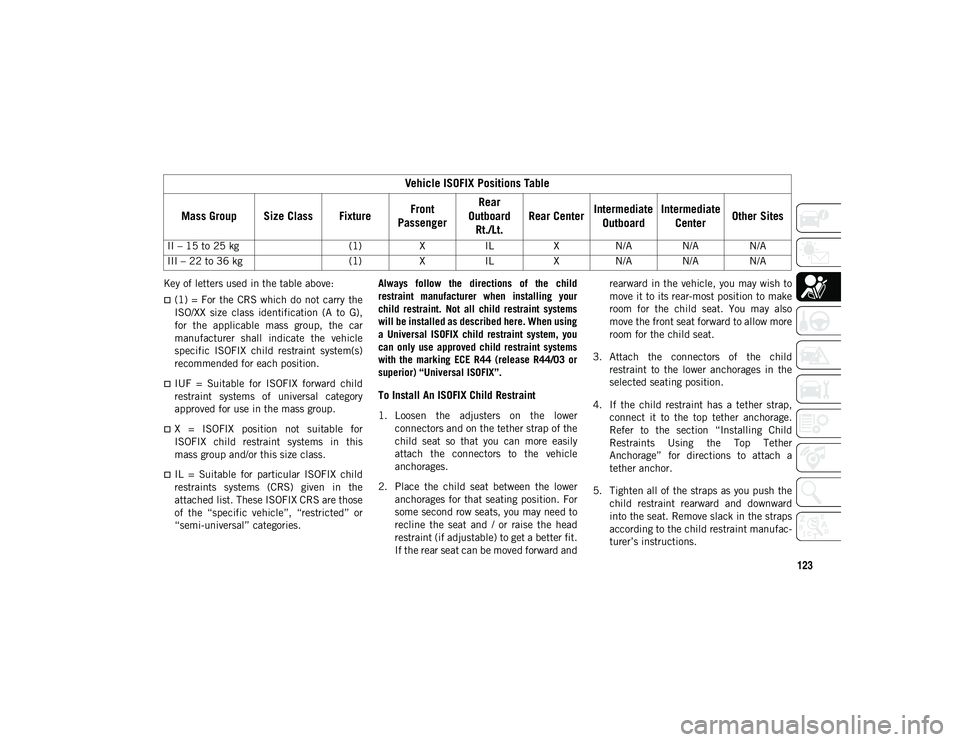
123
Key of letters used in the table above:
(1) = For the CRS which do not carry the
ISO/XX size class identification (A to G),
for the applicable mass group, the car
manufacturer shall indicate the vehicle
specific ISOFIX child restraint system(s)
recommended for each position.
IUF = Suitable for ISOFIX forward child
restraint systems of universal category
approved for use in the mass group.
X = ISOFIX position not suitable for
ISOFIX child restraint systems in this
mass group and/or this size class.
IL = Suitable for particular ISOFIX child
restraints systems (CRS) given in the
attached list. These ISOFIX CRS are those
of the “specific vehicle”, “restricted” or
“semi-universal” categories.Always follow the directions of the child
restraint manufacturer when installing your
child restraint. Not all child restraint systems
will be installed as described here. When using
a Universal ISOFIX child restraint system, you
can only use approved child restraint systems
with the marking ECE R44 (release R44/03 or
superior) “Universal ISOFIX”.
To Install An ISOFIX Child Restraint
1. Loosen the adjusters on the lower
connectors and on the tether strap of the
child seat so that you can more easily
attach the connectors to the vehicle
anchorages.
2. Place the child seat between the lower anchorages for that seating position. For
some second row seats, you may need to
recline the seat and / or raise the head
restraint (if adjustable) to get a better fit.
If the rear seat can be moved forward and rearward in the vehicle, you may wish to
move it to its rear-most position to make
room for the child seat. You may also
move the front seat forward to allow more
room for the child seat.
3. Attach the connectors of the child restraint to the lower anchorages in the
selected seating position.
4. If the child restraint has a tether strap, connect it to the top tether anchorage.
Refer to the section “Installing Child
Restraints Using the Top Tether
Anchorage” for directions to attach a
tether anchor.
5. Tighten all of the straps as you push the child restraint rearward and downward
into the seat. Remove slack in the straps
according to the child restraint manufac -
turer’s instructions.
II – 15 to 25 kg
(1)XIL XN/A N/A N/A
III – 22 to 36 kg (1)XIL XN/A N/A N/A
Vehicle ISOFIX Positions Table
Mass Group Size Class Fixture Front
Passenger Rear
Outboard Rt./Lt. Rear Center
Intermediate
Outboard Intermediate
Center Other Sites
2020_JEEP_M6_UG_UK.book Page 123
Page 126 of 328
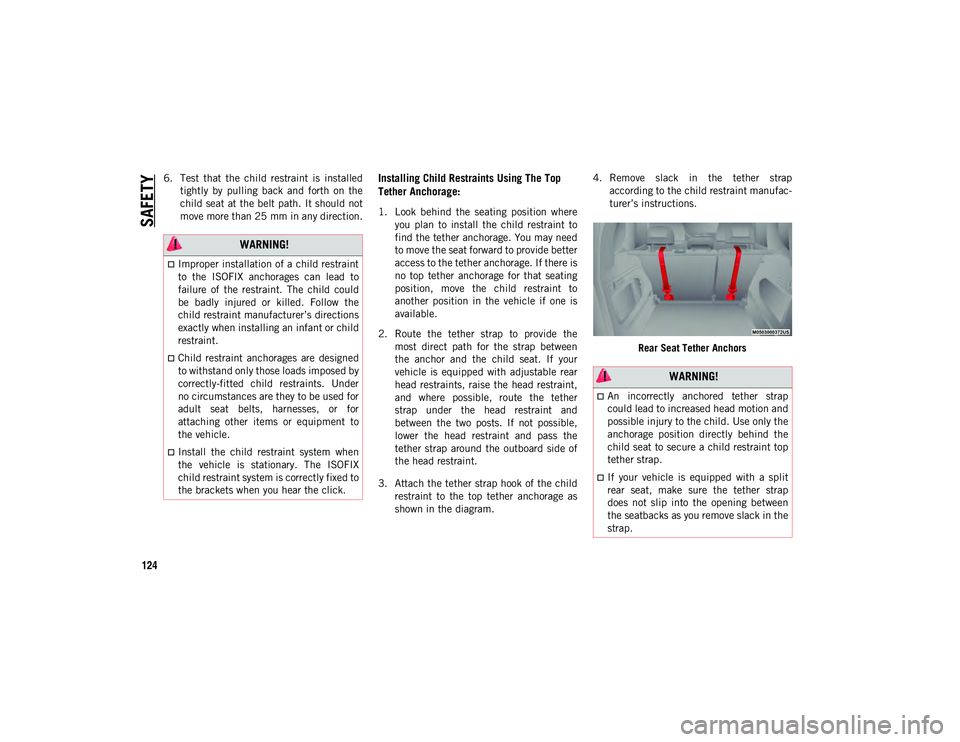
SAFETY
124
6. Test that the child restraint is installedtightly by pulling back and forth on the
child seat at the belt path. It should not
move more than 25 mm in any direction.Installing Child Restraints Using The Top
Tether Anchorage:
1. Look behind the seating position whereyou plan to install the child restraint to
find the tether anchorage. You may need
to move the seat forward to provide better
access to the tether anchorage. If there is
no top tether anchorage for that seating
position, move the child restraint to
another position in the vehicle if one is
available.
2. Route the tether strap to provide the most direct path for the strap between
the anchor and the child seat. If your
vehicle is equipped with adjustable rear
head restraints, raise the head restraint,
and where possible, route the tether
strap under the head restraint and
between the two posts. If not possible,
lower the head restraint and pass the
tether strap around the outboard side of
the head restraint.
3. Attach the tether strap hook of the child restraint to the top tether anchorage as
shown in the diagram. 4. Remove slack in the tether strap
according to the child restraint manufac -
turer’s instructions.
Rear Seat Tether Anchors
WARNING!
Improper installation of a child restraint
to the ISOFIX anchorages can lead to
failure of the restraint. The child could
be badly injured or killed. Follow the
child restraint manufacturer’s directions
exactly when installing an infant or child
restraint.
Child restraint anchorages are designed
to withstand only those loads imposed by
correctly-fitted child restraints. Under
no circumstances are they to be used for
adult seat belts, harnesses, or for
attaching other items or equipment to
the vehicle.
Install the child restraint system when
the vehicle is stationary. The ISOFIX
child restraint system is correctly fixed to
the brackets when you hear the click.
WARNING!
An incorrectly anchored tether strap
could lead to increased head motion and
possible injury to the child. Use only the
anchorage position directly behind the
child seat to secure a child restraint top
tether strap.
If your vehicle is equipped with a split
rear seat, make sure the tether strap
does not slip into the opening between
the seatbacks as you remove slack in the
strap.
2020_JEEP_M6_UG_UK.book Page 124
Page 127 of 328
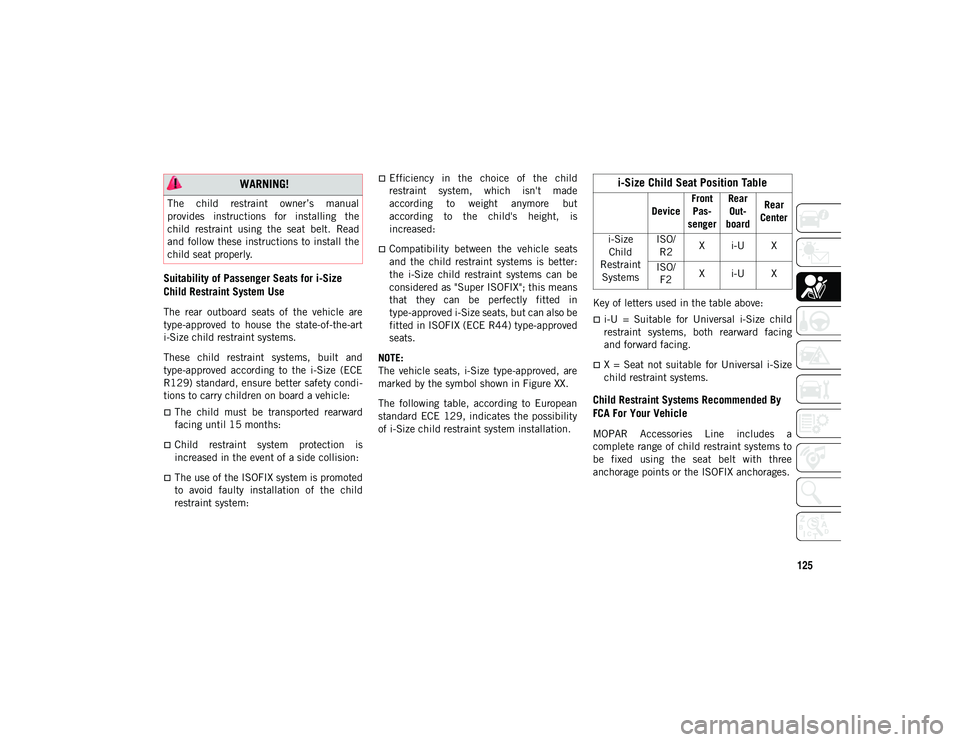
125
Suitability of Passenger Seats for i-Size
Child Restraint System Use
The rear outboard seats of the vehicle are
type-approved to house the state-of-the-art
i-Size child restraint systems.
These child restraint systems, built and
type-approved according to the i-Size (ECE
R129) standard, ensure better safety condi-
tions to carry children on board a vehicle:
The child must be transported rearward
facing until 15 months:
Child restraint system protection is
increased in the event of a side collision:
The use of the ISOFIX system is promoted
to avoid faulty installation of the child
restraint system:
Efficiency in the choice of the child
restraint system, which isn't made
according to weight anymore but
according to the child's height, is
increased:
Compatibility between the vehicle seats
and the child restraint systems is better:
the i-Size child restraint systems can be
considered as "Super ISOFIX"; this means
that they can be perfectly fitted in
type-approved i-Size seats, but can also be
fitted in ISOFIX (ECE R44) type-approved
seats.
NOTE:
The vehicle seats, i-Size type-approved, are
marked by the symbol shown in Figure XX.
The following table, according to European
standard ECE 129, indicates the possibility
of i-Size child restraint system installation. Key of letters used in the table above:
i-U = Suitable for Universal i-Size child
restraint systems, both rearward facing
and forward facing.
X = Seat not suitable for Universal i-Size
child restraint systems.
Child Restraint Systems Recommended By
FCA For Your Vehicle
MOPAR Accessories Line includes a
complete range of child restraint systems to
be fixed using the seat belt with three
anchorage points or the ISOFIX anchorages.
WARNING!
The child restraint owner’s manual
provides instructions for installing the
child restraint using the seat belt. Read
and follow these instructions to install the
child seat properly.
i-Size Child Seat Position Table
Device
Front
Pas -
senger Rear
Out -
board Rear
Center
i-Size Child
Restraint Systems ISO/
R2 X i-U X
ISO/ F2 X i-U X
2020_JEEP_M6_UG_UK.book Page 125
Page 128 of 328
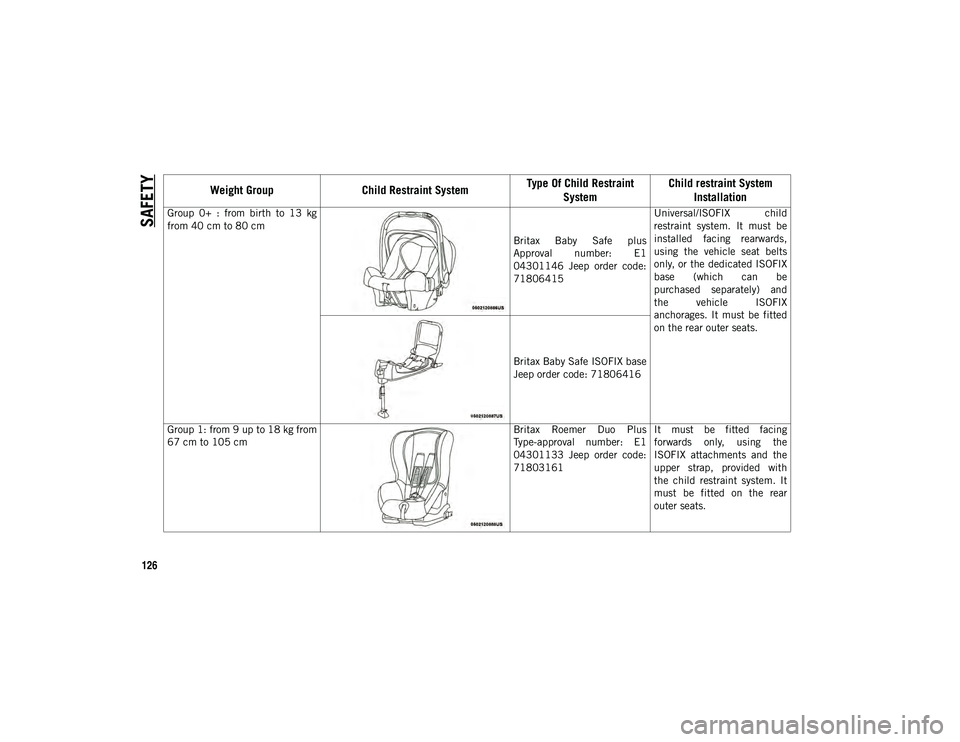
SAFETY
126Weight Group
Child Restraint System Type Of Child Restraint
System Child restraint System
Installation
Group 0+ : from birth to 13 kg
from 40 cm to 80 cm
Britax Baby Safe plus
Approval number: E1
04301146 Jeep order code:
71806415Universal/ISOFIX child
restraint system. It must be
installed facing rearwards,
using the vehicle seat belts
only, or the dedicated ISOFIX
base (which can be
purchased separately) and
the vehicle ISOFIX
anchorages. It must be fitted
on the rear outer seats.
Britax Baby Safe ISOFIX base
Jeep order code: 71806416
Group 1: from 9 up to 18 kg from
67 cm to 105 cm Britax Roemer Duo Plus
Type-approval number: E1
04301133 Jeep order code:
71803161It must be fitted facing
forwards only, using the
ISOFIX attachments and the
upper strap, provided with
the child restraint system. It
must be fitted on the rear
outer seats.
2020_JEEP_M6_UG_UK.book Page 126
Page 129 of 328
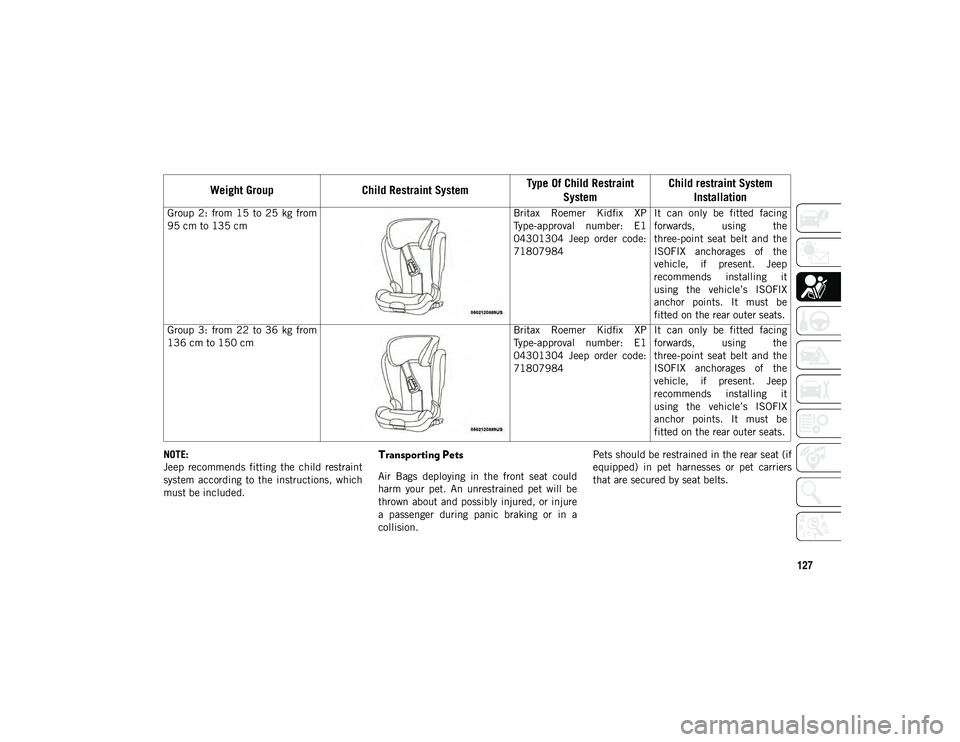
127
NOTE:
Jeep recommends fitting the child restraint
system according to the instructions, which
must be included.Transporting Pets
Air Bags deploying in the front seat could
harm your pet. An unrestrained pet will be
thrown about and possibly injured, or injure
a passenger during panic braking or in a
collision.Pets should be restrained in the rear seat (if
equipped) in pet harnesses or pet carriers
that are secured by seat belts.
Group 2: from 15 to 25 kg from
95 cm to 135 cm
Britax Roemer Kidfix XP
Type-approval number: E1
04301304 Jeep order code:
71807984It can only be fitted facing
forwards, using the
three-point seat belt and the
ISOFIX anchorages of the
vehicle, if present. Jeep
recommends installing it
using the vehicle’s ISOFIX
anchor points. It must be
fitted on the rear outer seats.
Group 3: from 22 to 36 kg from
136 cm to 150 cm Britax Roemer Kidfix XP
Type-approval number: E1
04301304 Jeep order code:
71807984It can only be fitted facing
forwards, using the
three-point seat belt and the
ISOFIX anchorages of the
vehicle, if present. Jeep
recommends installing it
using the vehicle’s ISOFIX
anchor points. It must be
fitted on the rear outer seats.
Weight Group
Child Restraint System Type Of Child Restraint
System Child restraint System
Installation
2020_JEEP_M6_UG_UK.book Page 127
Page 130 of 328
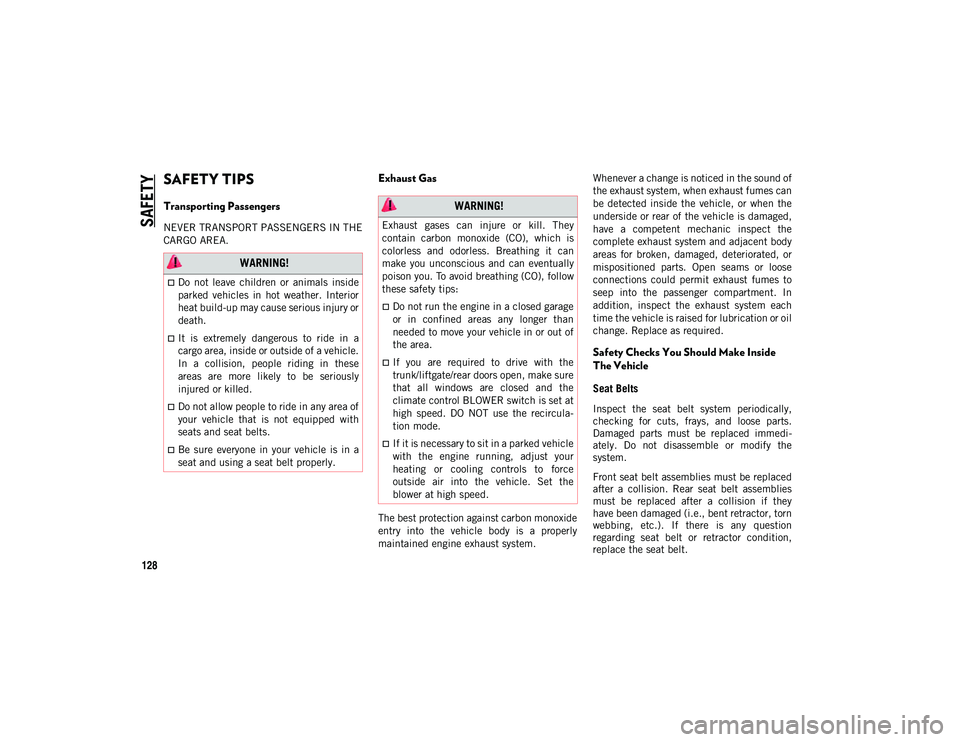
SAFETY
128
SAFETY TIPS
Transporting Passengers
NEVER TRANSPORT PASSENGERS IN THE
CARGO AREA.
Exhaust Gas
The best protection against carbon monoxide
entry into the vehicle body is a properly
maintained engine exhaust system.Whenever a change is noticed in the sound of
the exhaust system, when exhaust fumes can
be detected inside the vehicle, or when the
underside or rear of the vehicle is damaged,
have a competent mechanic inspect the
complete exhaust system and adjacent body
areas for broken, damaged, deteriorated, or
mispositioned parts. Open seams or loose
connections could permit exhaust fumes to
seep into the passenger compartment. In
addition, inspect the exhaust system each
time the vehicle is raised for lubrication or oil
change. Replace as required.
Safety Checks You Should Make Inside
The Vehicle
Seat Belts
Inspect the seat belt system periodically,
checking for cuts, frays, and loose parts.
Damaged parts must be replaced immedi
-
ately. Do not disassemble or modify the
system.
Front seat belt assemblies must be replaced
after a collision. Rear seat belt assemblies
must be replaced after a collision if they
have been damaged (i.e., bent retractor, torn
webbing, etc.). If there is any question
regarding seat belt or retractor condition,
replace the seat belt.
WARNING!
Do not leave children or animals inside
parked vehicles in hot weather. Interior
heat build-up may cause serious injury or
death.
It is extremely dangerous to ride in a
cargo area, inside or outside of a vehicle.
In a collision, people riding in these
areas are more likely to be seriously
injured or killed.
Do not allow people to ride in any area of
your vehicle that is not equipped with
seats and seat belts.
Be sure everyone in your vehicle is in a
seat and using a seat belt properly.
WARNING!
Exhaust gases can injure or kill. They
contain carbon monoxide (CO), which is
colorless and odorless. Breathing it can
make you unconscious and can eventually
poison you. To avoid breathing (CO), follow
these safety tips:
Do not run the engine in a closed garage
or in confined areas any longer than
needed to move your vehicle in or out of
the area.
If you are required to drive with the
trunk/liftgate/rear doors open, make sure
that all windows are closed and the
climate control BLOWER switch is set at
high speed. DO NOT use the recircula-
tion mode.
If it is necessary to sit in a parked vehicle
with the engine running, adjust your
heating or cooling controls to force
outside air into the vehicle. Set the
blower at high speed.
2020_JEEP_M6_UG_UK.book Page 128